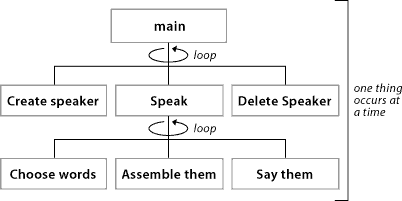| Lesson 2 | What is a thread? |
| Objective | Describe what Java means by the term thread |
Java Thread Defined
Before we look at what it means to have multiple threads, let us make sure we understand single threads. By thread, we mean
- thread of control or
- thread of execution.
What is a Java Thread ?
So what exactly is a thread? In Java, "thread" means two different things:
The
What mechanism allows the code to run concurrently?
The JVM, which gets its turn at the CPU by whatever scheduling mechanism the underlying OS uses, operates like a mini-OS and schedules its own threads, regardless of the underlying operating system. In some JVMs, the Java threads are actually mapped to native OS threads, but we will not discuss that here. It is not required to understand how threads behave in different JVM environments.
In fact, the most important concept to understand from this module is this:
When it comes to threads, very little is guaranteed. So be very cautious about interpreting the behavior you see on one machine as "the way threads work."
- An instance of class java.lang.Thread
- A thread of execution
The
main() method, which starts the thread process, runs in one thread, called the main thread. If you looked at the main call stack you would see that main() is the first method on the stack, the method at the bottom. But as soon as you create a new thread, a new stack materializes and methods called from that thread run in a call stack that is separate from the main() call stack. That second new call stack is said to run concurrently with the main thread.
What mechanism allows the code to run concurrently?
The JVM, which gets its turn at the CPU by whatever scheduling mechanism the underlying OS uses, operates like a mini-OS and schedules its own threads, regardless of the underlying operating system. In some JVMs, the Java threads are actually mapped to native OS threads, but we will not discuss that here. It is not required to understand how threads behave in different JVM environments.
In fact, the most important concept to understand from this module is this:
When it comes to threads, very little is guaranteed. So be very cautious about interpreting the behavior you see on one machine as "the way threads work."
Single Threaded Process
You might think of a single-threaded program as a pinball game in which you have only one ball at time. It is clear when to hit the flipper buttons, and you can follow this ball as it hits targets and bumpers. A single-threaded program starts with some initialization, performs its calculations, displays any results, and then ends. We have diagrammed an approach for a model of a town hall in the figure below. Of course, life gets more interesting when you have to deal with multiple threads. Let's look at those next.
